Sorted by date Results 1 - 25 of 46

With $20 million in DOE funding, MIT and 15 others are carrying out research that will open Schrödinger's box of potentially low-cost source of abundant green energy fuel. Hydrogen is the Schrödinger's Cat of clean energy fuels – it is both an abundant and affordable clean burning gas that fuels the dreams of a green energy future and a scarce element that comes with a carbon footprint that does not justify the cost to produce it. The U.S. Department of Energy's Advanced Res...

Supersonic experiments help identify atomic resilience in metamaterials for spacecraft, vehicles, helmets, or other objects. In a "sound-breaking" study conducted by engineers at Massachusetts Institute of Technology, a novel method has been unveiled for rapidly assessing the resilience of metamaterials and their architectures by exposure to supersonic impacts, positioning research toward possible nanoscale particle-proof protective hulls and segments that can withstand...
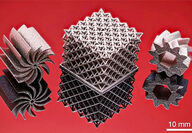
DOE national lab verifies stronger and more flexible 3D-printed metal. As additive manufacturing continues to shift from hobbyist to mainstream, research has ramped up to delve deeper into its expansive applications. A significant focus lies in the materials, such as those being called high-entropy alloys, that unlock unprecedented compositions unattainable through conventional methods. This innovation being explored by scientists has now been examined to its very atomic...

Introducing yet another innovation out of Massachusetts Institute of Technology, researchers have developed an additive manufacturing technique that can rapidly print liquid metal into large-scale parts like table legs and chair frames in a matter of minutes. To date, nearly 20 different methods of 3D printing are being utilized, most employing a technique of heating the material after it has been prepared. This is due to various factors, but generally because the material in...
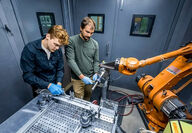
UW researchers explore capacity of tantalum cold spray technology to protect fusion reactors, prevent hydrogen loss. On the coattails of mankind's breakthrough in fusion technology, the University of Wisconsin-Madison is preemptively preparing a technology that could further stabilize the potential energy of a man-made micro-sun with a spray coating technology that could simultaneously maintain temperature integrity while also extracting the very fuel of a star – hydrogen. "...
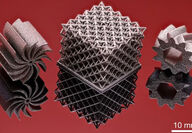
Strong and flexible, HEA offers the ideal additive manufacturing combination Scientists from the University of Massachusetts Amherst and the Georgia Institute of Technology have 3D printed a dual-phase, nanostructured, high-entropy alloy that exceeds the strength and ductility of other state-of-the-art additive manufactured materials and could be a game-changer for 3D printing. Led by assistant professor of mechanical and industrial engineering Wen Chen at UMass, and Ting...

Supply constraints slow installations; WoodMac expects li-ion batteries to dominate energy storage in US over next five years. The transition to clean electricity generated from intermittent sources such as solar and wind is energizing the energy storage sector in the United States. Supply chain constraints, however, are acting as an insulator to growth of battery installations that ensure the balance between energy supply and demand. According to the fourth quarter 2022 U.S....

Powering a remote zinc mine located roughly 600 miles northwest of Anchorage, Alaska, is a Herculean task. Governments and industry have taken a particular interest in remote arctic mining locations, not only because of the region's vast mineral resources but also because of shipping routes that are opening through the ice due to climate change. Still, getting energy to those locations is extremely difficult. First, a tanker must transport diesel fuel to a port on the Arctic...

Trapping qubits inside diamonds, MIT researchers create memory nodes that may unlock quantum computing realm. Quantum computers have the potential to carry out calculations millions of times faster than today's most advanced supercomputers, but this game-changing computing power has yet to be realized due to the fragile nature of qubits, the quantum realm equivalent of the bits that store and transfer data in today's computers. Diamonds, however, could provide the armor that p...

Young scientists brings lifetime of passion, curiosity, hope to producing better materials for fusion energy. Spurred by next-generation thinking, innovative uses of composite metal-ceramic 3D printing in the field of nuclear may just be the "Eureka!" moment needed to unlock one of Man's greatest accomplishments – fusion. When Alexander O'Brien sent in his application for graduate school at Massachusetts Institute of Technology's Department of Nuclear Science and E...
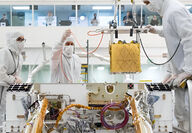
First-ever space habitat tech, experiment gives more than researchers expected. Not too dissimilar from Man's first Moon landing with a computer that by today's standards TI-83 calculators could overpower, when the first astronauts land on Mars, they will most likely equivocate today's microwave oven-sized device for the air they breathe and the rocket propellant that gets them home as some clunky technology future generations will be amazed could accomplish what it did. But...

While most leaders in the clean energy sector strongly indicate the concept of solid-state batteries is better, a few hurdles have long held this superior rechargeable battery in the realm of pacemakers and smartwatches, and out of electric vehicles where they are desperately needed. Solid-state technology replaces the liquid electrolyte in lithium batteries with a solid ceramic or polymer material. This increases energy density, stability, and heat resistance. For EV...

Joint development agreement for research into quantum dots for solar modules. Looking to evolve its already impressive proprietary cadmium-telluride thin-film solar technology, First Solar Inc. has partnered with UbiQD Inc., a New Mexico-based nanotechnology company, to explore the possibilities of incorporating quantum dot technology into a next-gen solar system. In its simplest form, a quantum dot is a man-made nanoscale crystal that can conduct electricity, consisting of a...

Common cement and carbon black pave the way for a foundational tech for efficient future energy storage. Channeling the power of the ancients, a team at the Massachusetts Institute of Technology announced they have developed a supercapacitor from two of humanity's most ubiquitous historical materials – cement and carbon black. Possibly the foundation of a novel, low-cost energy storage system, according to a new study, this technology could facilitate the use of renewable e...

Forward-thinking utility works with Ambri on demo-scale deployment of molten metal battery for clean energy storage. With the electric vehicle revolution demanding lithium-ion battery materials faster than mining companies can supply them, alternative systems for stationary renewable energy storage are needed. One such solution is the Ambri Liquid Metal battery that is being tested on a commercial scale by Xcel Energy, a forward-leaning utility company that delivers energy to...

In an effort to curb global warming, Purdue University researchers developed a cool solution – paint. But not just any paint, with what they believe to be the closest opposite of the blackest black, this ultra-white paint can not only repel heat but cool down the interior of the surface it is painted on. In September 2021, the Purdue team created an ultra-white paint that earned the Guinness World Record for an unintended side effect to reducing global warming, creating the w...

Solid and durable, concrete is the second-most consumed material on Earth, surpassed only by water. The gray, porous building material is also the foundation of modern infrastructure. But concrete leaves a hefty carbon footprint on the environment. During its manufacture, large quantities of carbon dioxide are released into the atmosphere, both as a chemical byproduct of cement production and in the energy required to fuel the process. Despite its advantages, which include...

Seeking an affordable and safer alternative to lithium-ion batteries for the storage of intermittent clean energy from wind and solar, a global team of researchers led by an award-winning chemist at the Massachusetts Institute of Technology has developed a new rechargeable battery made with affordable and readily available materials – aluminum, sulfur, and molten salts. "I wanted to invent something that was better, much better, than lithium-ion batteries for small-scale s...

Struggling to overcome the inevitable shortcomings of miniaturizing digital technologies due to the inherent limits of silicon, Massachusetts Institute of Technology researchers have potentially reinstated Moore's Law with the synthesis of 2D materials on silicon wafers. True to Moore's Law, the number of transistors on a microchip has doubled every year since its origination in 1965; however, this trajectory is predicted to soon plateau because silicon – the backbone of m...
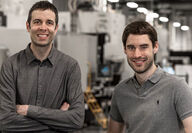
VulcanForms is elevating metal 3D printing to the next stage of AM industrialization. Spun out from a Massachusetts Institute of Technology alumnus and professor duo, VulcanForms is pushing the boundary on digital manufacturing as a service for companies using its proprietary laser powder bed fusion metal 3D printers to build industrial products at scale. While cutting-edge additive manufacturing offers a world of possibilities for companies looking to transform their...
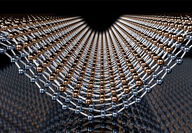
Researchers postulate graphene can be transistor, superconductor simultaneously. With the breakthroughs in quantum technologies that graphene has enabled, among countless other discoveries this physics-bending 2D carbon has warranted, researchers need only find the right pattern to truly unlock the potential of this miracle material. Supported by the landmark discovery of "twisted graphene," scientists at ETH Zurich Laboratory for Solid State Physics have added yet another...
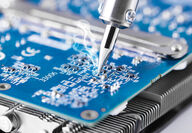
From flashlights to supercomputers, tin is the glue for an electronic age Lost in the clamor for lithium, nickel and other metals needed for the batteries powering electric vehicles and modern electronics, or the rare earth elements that turn stored energy into motion, is the enormous need for a much more modest metal that is so fundamental to the advancement of technology that it almost goes unseen – tin. While other technology metals are critical to certain products and s...

Russia and China's control of global supplies worry DC lawmakers From its uses in flame retardants that have saved countless American lives to being an important ingredient in batteries poised to be the answer to the challenge of storing intermittent renewable energy, few metals are more critical to the national security and economic wellbeing of the United States than antimony. Described as a metalloid, which means it falls somewhere between metals such as zinc and solid...

MIT develops a wearable sensor able to target any biomarker Using a gold-gallium "band-aid" could prove the next generation of biological monitoring as researchers from the Massachusetts Institute of Technology have devised a new kind of wearable sensor capable of communicating wirelessly without the need for microchips or even batteries. Wearable sensors are ubiquitous due to wireless technology, which enables the monitoring of glucose concentrations, blood pressure, heart...
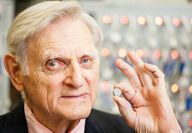
Ask anyone, "who invented the lightbulb?" and most would be able to answer Thomas Edison. Ask anyone, "who invented the telephone?" and some would be able to answer Alexander Graham Bell. Ask anyone, "who invented the lithium-ion battery powering your smartphone and laptop?" and perhaps scant few would be able to answer John Goodenough. Along with his colleagues Stanley Whittingham and Akira Yoshino, Goodenough was jointly bestowed the 2019 Nobel Prize in Chemistry for the...